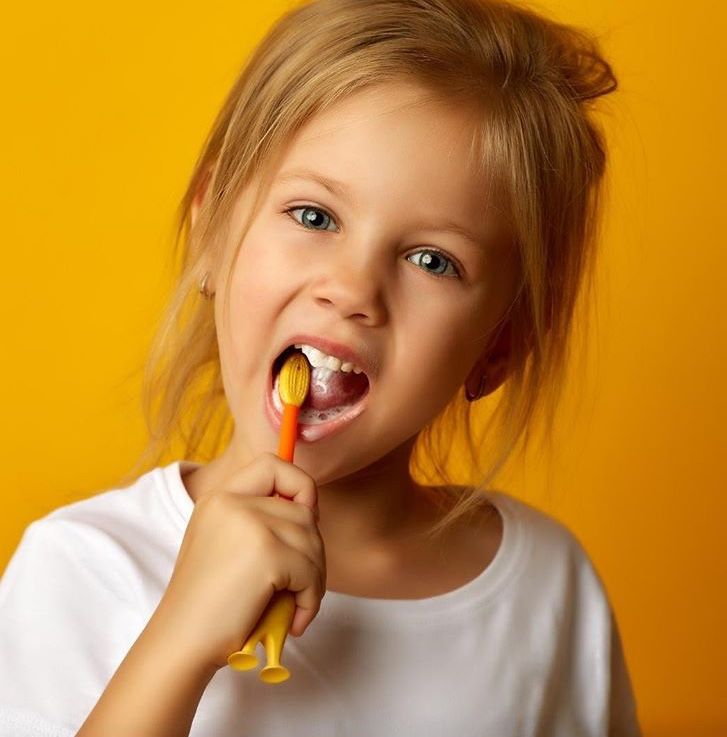Fluoride is a key mineral that strengthens tooth enamel, prevents tooth decay, and helps in the remineralization of early decay. Fluoride applications for children are commonly used as a preventive measure to promote oral health. Here’s a detailed overview: What is Fluoride Application?Fluoride application involves applying a concentrated form of fluoride directly to a child’s teeth by a dental professional. It can be in the form of varnishes, gels, foams, or rinses. Types of Fluoride TreatmentsFluoride Varnish: A sticky, paint-like substance applied to teeth with a brush.Adheres to the tooth surface and releases fluoride over time.Typically applied twice a year, or more often for high-risk children. Fluoride Gels and Foams: Applied using trays that fit over the teeth.Used in dental offices, usually for older children who can sit still for the application.Fluoride Rinses: Contains a lower concentration of fluoride.Often recommended for at-home use under supervision for children who can spit it out.Benefits of Fluoride Application for Children Strengthens Tooth Enamel: Enhances the ability of teeth to resist decay.Helps in repairing early stages of cavities by remineralizing weak enamel. Prevents Cavities: Reduces the risk of tooth decay by up to 43% in primary and permanent teeth.Protects Against Bacteria: Inhibits the growth of harmful oral bacteria. Avoid Excessive Fluoride: Overexposure can lead to dental fluorosis (white spots on teeth), so it’s crucial to balance fluoride intake.Steps in Fluoride Varnish ApplicationTeeth are cleaned and dried.Fluoride varnish is applied with a small brush.Child is instructed not to eat or drink for 30 minutes.PrecautionsEnsure fluoride varnish is reapplied at the recommended intervals.Do not allow children to swallow fluoride products.By including fluoride applications as part of a regular dental care routine, parents can ensure strong, healthy teeth for their children and significantly reduce the likelihood of cavities.
Why Do Kids Suck Their Thumbs?
Ah, you’re referring to thumb sucking in kids, which is a common habit, especially in young children. Why Do Kids Suck Their Thumbs?Self-soothing: Thumb sucking is a natural reflex for babies. It helps them feel secure and calm.Comfort: It can serve as a coping mechanism when they are tired, stressed, or bored.Hunger: For infants, it can be a sign of hunger.When Does It Become a Concern?Thumb sucking is usually harmless in infants and toddlers. However, it can cause issues if it continues beyond the age of 4-5 years: Dental problems: Prolonged thumb sucking can affect the alignment of teeth and the shape of the jaw.Speech issues: It might interfere with tongue placement, leading to speech difficulties.Skin problems: Prolonged sucking can cause irritation or calluses on the thumb.How to Help a Child Stop Thumb SuckingPositive reinforcement: Praise your child when they don’t suck their thumb. How to Help a Child Stop Thumb SuckingPositive reinforcement: Praise your child when they don’t suck their thumb.Identify triggers: Pay attention to when and why they do it (e.g., stress, boredom) and address those situations.Offer alternatives: Provide a comforting item like a stuffed toy or blanket.Use reminders: Gentle reminders can help older children become aware of the habit.Talk to them: Explain in simple terms why stopping the habit is important.When to Seek HelpIf thumb sucking persists and affects the child’s teeth or behavior, consult: A pediatric dentist to address dental concerns.A pediatrician for advice and support.
New year Resolution for Dental cavity
Commit to excellent oral health care habits and make proactive choices to maintain cavity-free teeth throughout the year.” Let your smile sparkle brighter than the festive lights! and Make your dental health a priority as you prepare for the New Year. A great New Year’s resolution for preventing dental cavities could be: “Commit to excellent oral health care habits and make proactive choices to maintain cavity-free teeth throughout the year. ” Let your smile sparkle brighter than the festive lights! and Make your dental health a priority as you prepare for the New Year. The Soul Dentistry and Implants provides quality dental care to patients in the Post Oak, Houston, TX and surrounding areas like southwest Houstan, Meyerkland and Robindell .It focusing on a comprehensive approach to oral health and is the best option available for any type of Dental Problem . Here are some actionable steps to support this resolution: Brush Twice Daily: Use fluoride toothpaste and a soft-bristled toothbrush for at least two minutes, morning and night. Floss Regularly: Clean between your teeth daily to remove food particles and plaque. Use Interdental Brushes: For added effectiveness in cleaning between teeth. Reduce Sugar Intake: Limit sugary snacks and drinks that promote cavity formation. Stay Hydrated: Drink plenty of water, preferably fluoridated, to help wash away food particles and bacteria. Eat a Balanced Diet: Include foods rich in calcium and phosphorus for strong teeth. Regular Dental Check-ups: Visit your dentist every six months for professional cleaning and early detection of potential issues. Chew Sugar-Free Gum: Stimulate saliva production to protect against cavities. Use Mouthwash: Opt for one with fluoride to strengthen enamel and fight bacteria. Avoid Tobacco Products: These can lead to oral health issues, including cavities. Start small by incorporating one or two habits and build on them throughout the year! Call us at :(713) 551-9400, Mail us at : souldentistry2020@outlook.comor visit https://souldentalimplants.com/home to schedule your appointment. Find us at: 10350 S Post Oak Rdsuite h, Houston,Houston TX 77035.
Does Dental Floss is useful ?
Use about 18 inches of floss and wind it around your fingers, leaving 1-2 inches for working. Gently slide the floss between your teeth using a sawing motion. dental floss is very useful! It plays an essential role in oral hygiene by helping to clean areas of the mouth that a toothbrush cannot easily reach, such as between the teeth and under the gumline. Here’s why dental floss is beneficial: Removes Plaque and Debris: Flossing removes food particles and plaque buildup between teeth, preventing cavities and gum disease. Prevents Gum Disease: By cleaning below the gumline, flossing helps prevent gingivitis (early-stage gum disease) and periodontitis. Reduces Bad Breath: Removing trapped food particles between teeth helps reduce bacteria, a common cause of bad breath. Enhances Overall Oral Health: Regular flossing, combined with brushing and rinsing, contributes to healthier gums and teeth. Tips for Effective Flossing:Use about 18 inches of floss and wind it around your fingers, leaving 1-2 inches for working.Gently slide the floss between your teeth using a sawing motion.Curve the floss into a C shape around each tooth and clean below the gumline.Use clean sections of floss for each tooth.If traditional floss is difficult to use, alternatives like floss picks, water flossers, or interdental brushes can be helpful. visit https://souldentalimplants.com/home to schedule your appointment. Find us at: 10350 S Post Oak Rdsuite h, Houston,Houston TX 77035.
Root Canal Therapy
Root Canal Therapy Root canal is one of the most common dental procedures performed, well over 14 million every year. This simple treatment can save your natural teeth and prevent the need for dental implants or bridges. At the center of your tooth is pulp. Pulp is a collection of blood vessels that helps to build the surrounding tooth. Infection of the pulp can be caused by trauma to the tooth, deep decay, cracks, and chips, or repeated dental procedures. Symptoms of the infection can be identified as visible injury or swelling of the tooth, sensitivity to temperature or pain in the tooth, and gums. We will happily communicate with you all the various quality dental services available best option available for any type of Root Canal Treatment . If you experience any of these symptoms, your dentist will most likely recommend non-surgical treatment to eliminate the diseased pulp. This injured pulp is removed and the root canal system is thoroughly cleaned and sealed. This therapy usually involves local anesthesia and may be completed in one or more visits depending on the treatment required. CAN ALL TEETH BE TREATED ENDODONTICALLY? Most teeth can be treated. Occasionally, a tooth can’t be saved because the root canals are not accessible, the root is severely fractured, the tooth doesn’t have adequate bone support, or the tooth cannot be restored. However, advances in endodontics are making it possible to save teeth that even a few years ago would have been lost. When non-surgical endodontic treatment is not effective, endodontic surgery may be able to save the tooth (see Apicoectomy Surgical Retreatment). We recommend that you call your restorative dentist as soon as possible to make your follow-up appointment. Dentists’ schedules tend to book quickly. It is recommended that you have your permanent restoration placed 2-3 weeks after your root canal treatment to allow healing to take place, but not longer than one month after the procedure. This step is imperative for the long-term prognosis of your tooth. The temporary filling placed in the biting surface of your tooth is designed to last ideally two to four weeks, not longer than six to eight weeks. It is crucial to see your general dentist for a permanent restoration. Waiting longer than eight weeks can cause your temporary filling to leak, thus contaminating your newly completed root canal therapy. Find us at: 10350 S Post Oak Rdsuite h, Houston,Houston TX 77035.
Dental Emergency
Dental Emergency A dental emergency refers to an urgent situation involving the teeth, gums, or mouth that requires immediate attention to alleviate severe pain, stop bleeding, or save a tooth. Here are some common types of dental emergencies and the appropriate steps to take for each: Common Dental Emergencies: Toothache: Symptoms: Severe, persistent pain; swelling; sensitivity to hot or cold.Immediate Actions: Rinse mouth with warm water, floss to remove food particles, apply a cold compress to reduce swelling, and take over-the-counter pain relievers. Avoid placing aspirin directly on the gums. Chipped or Broken Tooth: Symptoms: Visible damage to the tooth, pain, sensitivity.Immediate Actions: Save any pieces of the tooth if possible. Rinse mouth with warm water. Apply gauze to any bleeding area for about 10 minutes or until bleeding stops. Use a cold compress to reduce swelling. See a dentist immediately. Immediate Actions: Rinse the mouth with warm salt water. Apply pressure with a clean cloth or gauze to stop bleeding. Use a cold compress to minimize swelling. If bleeding persists after 10-15 minutes or is severe, seek emergency medical attention. Immediate Care: Addressing the emergency promptly can prevent complications and improve outcomes.Emergency Contact: Keep your dentist’s emergency contact information readily available.Preventive Measures: Regular dental check-ups, wearing mouthguards during sports, and avoiding hard foods can help prevent some dental emergencies. When to Seek Immediate Medical Attention: If you experience severe pain, uncontrollable bleeding, or have a traumatic injury to the face or mouth, it’s crucial to seek immediate medical or dental care. Some situations may require going to the emergency room, especially if there is a risk of infection or the injury affects breathing or swallowing. Symptoms: Cuts, tears, or punctures in the lips, cheeks, gums, or tongue.Immediate Actions: Rinse the mouth with warm salt water. Apply pressure with a clean cloth or gauze to stop bleeding. Use a cold compress to minimize swelling. If bleeding persists after 10-15 minutes or is severe, seek emergency medical attention. General Tips for Handling Stay Calm: Keeping calm helps you manage the situation more effectively and avoid further injury.Immediate Care: Addressing the emergency promptly can prevent complications and improve outcomes.Emergency Contact: Keep your dentist’s emergency contact information readily available. When to Seek Immediate Medical Attention: If you experience severe pain, uncontrollable bleeding, or have a traumatic injury to the face or mouth, it’s crucial to seek immediate medical or dental care. Some situations may require going to the emergency room, especially if there is a risk of infection or the injury affects breathing or swallowing. Call us at +1-972-351-9110 to schedule your appointment. Find us at:1011 N Hwy 77, Ste 105Waxahachie, TX 75165.
Denture
A full denture is a removable dental appliance that replaces all of the natural teeth in either the upper or lower jaw, or both. Here are some key points about full dentures: The Brownfield dentist in Brownfield is conveniently located near to the Brownfield Sport Complex and Coleman Park is the best option available for any type of Dental Problem Types of Full DenturesConventional Full Dentures: These are made and placed in the mouth after any remaining teeth are removed and the tissues have healed.Immediate Full Dentures: These are placed immediately after the remaining teeth are removed. Adjustments are often needed as the gums heal and shrink. Implant-Supported Full Dentures: These are anchored to dental implants placed in the jawbone, offering more stability compared to conventional dentures.Benefits of Full DenturesRestored Appearance: They provide a natural-looking replacement for missing teeth, improving facial aesthetics. Care and MaintenanceCleaning: Dentures should be removed and cleaned daily with a soft brush and denture cleaner.Soaking: Soak dentures in a denture-cleaning solution overnight to keep them moist and maintain their shape.Regular Dental Visits: Regular check-ups with a dentist are important to ensure the dentures fit well and to check for any oral health issues.
Dental Bridge
A dental bridge is a dental prosthetic used to replace one or more missing teeth. It “bridges” the gap between existing teeth or dental implants. The bridge consists of one or more artificial teeth (pontics) anchored in place by dental crowns or abutments on either side. Types of Dental Bridges There are several types of dental bridges to suit different needs: Traditional Dental Bridge: This is the most common type and consists of pontics held in place by dental crowns on the adjacent natural teeth. Cantilever Bridge: When you have only one adjacent tooth to support the pontic, a cantilever bridge is used. It’s less common due to the added stress on the supporting tooth. Maryland Bridge (Resin-Bonded Bridge): Maryland bridges use a framework of metal or porcelain wings bonded to the back of the adjacent teeth, making it a more conservative option. Implant-Supported Bridge: For cases where multiple teeth are missing, dental implants can be used to support the bridge. This is a secure and long-lasting solution. Restored Appearance: Dental bridges fill the gaps left by missing teeth, which can significantly improve a patient’s appearance. This restoration can boost self-esteem and confidence, as it allows the patient to smile, speak, and eat without feeling self-conscious about their missing teeth.
Dental Cap and Crown
A dental cap and a dental crown are essentially the same thing. Both refer to a restorative dental device used to cover a tooth to improve its shape, size, strength, or appearance. Here’s a detailed breakdown: What is a Dental Crown (or Cap)?A dental crown is a custom-made covering that fits over a tooth.It restores the tooth’s functionality and aesthetics, especially if the tooth is damaged, decayed, or worn down.Uses of a Dental Crown:Protection: To protect a weakened tooth (e.g., due to decay or fracture) from breaking. A temporary crown is placed (if necessary) while the permanent one is made.The permanent crown is cemented or bonded in place.Care for a Dental Crown:Brush and floss regularly to maintain gum health.Avoid hard or sticky foods that could damage or dislodge the crown.Visit your dentist regularly for check-ups. Restoration: To restore a broken or severely worn tooth.Support: To support a tooth with a large filling when there isn’t much natural tooth structure left.Cosmetics: To cover misshapen or severely discolored teeth.After Root Canal: To protect a tooth after a root canal procedure.Anchor for Bridges: To hold a dental bridge in place. Types of Dental Crowns:Metal Crowns: Made of alloys like gold or other metals; highly durable but noticeable.Porcelain-Fused-to-Metal (PFM): Combines durability with a natural look.Ceramic or Porcelain Crowns: Natural-looking and suitable for front teeth.Resin Crowns: Less expensive but not as durable.Zirconia Crowns: Highly durable and aesthetically pleasing.Temporary Crowns: Often made of acrylic or stainless steel, used while waiting for a permanent crown.Procedure:The dentist prepares the tooth by shaping it and removing decay.An impression of the tooth is taken for creating a custom crown. Call us at :(713) 551-9400, Mail us at : souldentistry2020@outlook.comor visit https://souldentalimplants.com/home to schedule your appointment. Find us at: 10350 S Post Oak Rdsuite h, Houston,Houston TX 77035.
Cosmetic Dentistry
Cosmetic dentistry focuses on improving the appearance of a person’s teeth, gums, and overall smile. It is a specialized field of dental care that combines science and art to enhance aesthetics, boost confidence, and in some cases, improve oral functionality. Cosmetic dentistry focuses on improving the appearance of a person’s teeth, gums, and overall smile. It is a specialized field of dental care that combines science and art to enhance aesthetics, boost confidence, and in some cases, improve oral functionality. Teeth Whitening: Removes stains and discoloration to brighten the smile. Dental Veneers: Thin shells made of porcelain or composite resin that cover the front surface of teeth to correct imperfections like chips, stains, or gaps. Dental Bonding: Uses a tooth-colored resin to repair chips, cracks, or gaps. Orthodontics: Includes braces or aligners to straighten misaligned teeth. Dental Implants: Replaces missing teeth with artificial teeth anchored into the jawbone. Tooth Contouring and Reshaping: Smooths and shapes uneven or jagged teeth. Gum Contouring: Adjusts gum lines to correct a “gummy smile.” Benefits of Cosmetic Dentistry: Improves the aesthetic appeal of teeth and gums. Boosts self-esteem and confidence. Enhances oral functionality (in some cases, like dental implants or orthodontics). Cosmetic dentistry is a blend of dental expertise, technology, and artistry, offering solutions tailored to individual needs for a radiant and healthy smile.










